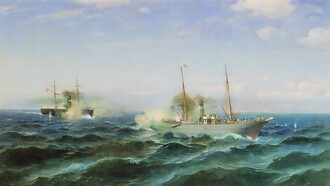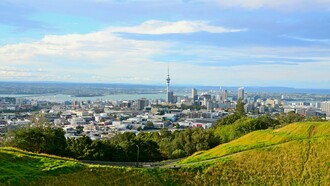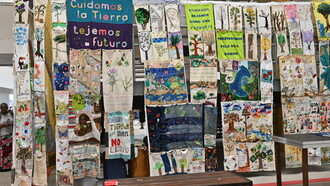“We are worried that if the government extends marine protected areas, we will lose access to our fishing grounds,” said young fisherman Aaron Chacon, standing on a beach at Tárcoles, Costa Rica.
Behind him, his fellow fishers were bringing in their daily catch, and there was plenty of good-humoured shouting and gesturing going on.
“We have been collecting piangua (molluscs) for generations here, and have never harmed the ecosystem or any species. But the government says only so many of us can be registered, and for the rest of us, our survival itself is illegal!”, said mollusc collector or pianguero Rufina Gomez as we boated through a thriving manglar (mangrove) forest in the coastal area of Puerto Cortes.
I was in Costa Rica, visiting small-scale fisher and coastal communities on the Middle and South Pacific coasts. My hosts were members of CoopeSoliDar R.L., a cooperative set up in 2000 as a trans-disciplinary forum that could help communities. Over the last 25 years, CoopeSoliDar R.L. has assisted small-scale producers on the coasts to gain rights and access to livelihood resources, reach just markets that can help sustain their livelihoods and obtain health and education services.
Just before visiting Tárcoles, they had taken me to parts of the coast that had been sold off to rich investors. Bustling fisher or farming communities had been replaced by glitzy homes, golf courses, surfing resorts, whale-watching tourist facilities, and amusement parks for wealthy people from across the world. From CoopeSoliDar R.L. members who were my travel colleagues on this trip, and subsequently, in discussions with other Costa Rican researchers and activists, I heard of other forms of marginalization and dispossession, including what remains of the country’s Indigenous peoples (already nearly decimated by a brutal Spanish occupation during the colonial period). In the two weeks I spent there in late June and early July this year, visiting coastal and inland areas in the west, south, and central regions, I witnessed or heard many accounts of this disturbing underbelly of the country’s famed sustainable development story.
A welfare and conservation story straying off course
Costa Rica is globally known for its commitment to both human welfare, and the conservation of its biodiversity, including the regeneration and restoration of forests which were nearly completely decimated by the 1980s. For many decades it has ranked amongst the highest in terms of investments for education, health, energy and other aspects of welfare (many of these guaranteed as free services by the state), performing well in the achievement of some of the Sustainable Development Goals (SDGs).
It is also one of the first countries to declare a target for achieving carbon neutrality (by 2050), and its share of renewable energy in the total electricity generation is nearly 100% (though this includes controversial hydro projects, and there remains heavy dependence on fossil fuels for sectors like transportation). Protected areas for wildlife conservation cover nearly 29% of its land area, and about 30% of its marine territory, aiming to conserve an estimated 5% of the world’s biodiversity (in only 0.03% of its landmass). It is commendably one of the few countries in the world without an army.
In the last couple of decades, though, this narrative is beginning to display several challenges. The focus on welfare through the public sector has weakened, with reduced or stagnant outlays for sectors like education, yielding way to the privatization of many services. Levels of inequality have been rising or remaining stagnant, with significant marginalization of sections like Afrodescendants, Indigenous peoples, and Nicaraguan migrants. Its current government, led by a right-wing party, wants to reduce welfare-related budgetary outlays. It is actively encouraging further privatization of lands and resources and trends towards gentrification that are very noticeable in many parts of the country.
In the name of climate and biodiversity action, Costa Rica has also introduced several "Payment for Ecosystem Services" (PES) schemes, and carbon-related market mechanisms, including controversial measures like reforestation to offset carbon emissions of rich countries and corporations such as Norwegian energy companies. Most PES projects are oriented to private landowners, consolidating unequal property ownership. According to several observers, in the absence of secure tenurial rights for Indigenous peoples and other communities (on which more, below), and because the payments were made to individuals and not collectives, such schemes in most cases, have distorted local economies and caused divisions within communities.
The commercialization of biodiversity and biological resources has always been controversial. I recall that when I was working on biodiversity policy issues and active in the IUCN and Biodiversity Convention circles in the 1990s, one case that frequently came up for both appreciation and criticism was the bioprospecting deal that Costa Rica’s National Biodiversity Institute (INBio) had with the pharmaceutical giant corporation Merck. The deal was supposed to bring the country US$300 million per year, in exchange for making all the collected biodiversity specimens available to the company. The money never materialized, but meanwhile, access was provided for over two decades, till finally INBio, unable to maintain its collections, had to hand them over to the government in 2015.
Another disturbing trend is the introduction of massive African palm plantations (for oil). I was stunned into silence when we drove from Tarcoles to Cortes, passing many miles of these. Where they have replaced mixed forests, they would be devastating for biodiversity; where they have come up on agricultural lands, they would have had other ecological and social impacts. It is also a sign of things, that one of Costa Rica’s biggest foreign exchange earners now is sport fishing by the rich – a lot of it in areas that were once used by traditional fishers (though some individuals from local communities do also get decent incomes from it). Eduard Müller, one of Costa Rica’s foremost experts on regeneration, whom I met on this trip two decades after we were together in the World Commission on Protected Areas, told me that the country’s commitment to biodiversity was sadly waning and landgrab by the rich or for monoculture plantations was alarming.
According to the 2023 State of the Nation, brought out by the Consejo Nacional de Rectores (National Council of Rectors): "Costa Rica is immersed in the immediacy of the situation; it has taken off the high beams and neglected the course". The report points out that Costa Rica is among the countries with the greatest inequality in income distribution in the continent and the OECD, and has regressed in environmental actions.
Gentrification and exclusionary conservation
The gentrification of the coast, caused by land value speculation, allowing non-Costa Ricans to buy land, real estate expansion, massive tourism and marina development, all of these aided by a pliable legal system, has caused displacement and dispossession of local communities. The other, ironically, is wildlife and biodiversity conservation. As in many other parts of the world, Costa Rica’s protected areas have been established to stem the horrific decline of wildlife populations and biological diversity. They have undoubtedly helped to some extent in doing so, including by discouraging destructive commercial or ‘developmental’ activities.
However, since they are based on a Western model of conservation which seeks to exclude human activities, and relies on a centralized (even if weak in front of commercial forces) agency to implement conservation measures, they have led to displacement and dispossession of communities who have inhabited such areas for generations or centuries. They have also neglected the knowledge and institutional arrangements such communities have used to govern and manage the commons, arrogantly assuming that only state or private agencies know how to conserve.
The sidelining of piangueros (mollusk collectors) in the management of the Terraba Sierpe National Wetlands reserve, and the criminalization of many of them who are non-formalised, despite having very low-impact livelihoods, is a classic example of this. At one point on our boat trip through the reserve, we witnessed a small group of piangueros going about their business, and at another point, we got off on an island to try it out for ourselves. No one was using any machinery or equipment, everything was done with hands, and one could see that this would have little if any ecological impact. Benancia Rodriguez, one of the gatherers, told us that if a mollusc they dig out is below a certain size, they put it back into the ground. Their associations have also established other such rules for sustainability, such as not collecting another mollusk species that is endangered, except for local domestic consumption.
At a gathering of collectors called by CoopeSoliDar R.L., in Cortes town, Rufina Gomez, President of one of the four local associations of collectors, said that for the last many decades, they had not seen any reduction in the population of molluscs, nor any other significant changes in the ecosystem or wildlife. With two exceptions: a major invasion by a species of fern Acrostichum aureum, and the conversion of the mangroves into plantations by a private agency. They were not aware of why the former was taking place. I found out later that it began when there was major deforestation of mangroves in the 1980s, as a desperate measure by communities after Costa Rica’s banana boom collapsed. This left open areas for the fern to invade. As for the latter, it was a mystery as to why this was being allowed inside a reserve, while at the same time fining mollusc collectors if they were unregistered or went beyond a government-imposed limit!
Unfortunately, according to CoopeSoliDar R.L, most of the big conservation NGOs active in Costa Rica (and it is a favourite hunting ground for them!) have been complicit in (or even responsible for promoting) such exclusionary policies. At Playa Uvita, down the south-western coast, we entered what used to be a rural settlement of fishers; it was now replaced by resorts, shops, and boat hire services for visitors to the Parque Nacional Marino Ballena, a major attraction for whale-watching. While this conversion was taking place, local people were assured that they could run the tourism services and earn a ‘better’ livelihood than in fishing. But few could afford the investments needed for tourist infrastructure and boats, and most simply moved out.
There seem to be exceptions. Osa Conservation, an NGO working in southern Costa Rica, claims that it is working with local communities to build capacity for conservation and sustainable livelihoods. It cites research that shows a decline in mollusc populations, contrary to what local collectors believe, and so it feels that there is a need for some alternative livelihood to enable recovery of populations. But one factor in reduced mollusc populations could also be the invasive fern. Marco Hidalgo, a Costa Rican, and the Community and Conservation Outreach Manager in Osa Conservation’s Puerto Jimenez office, told me of its project to restore affected mangroves, in which piangueros are involved, in the process of getting an additional source of livelihood. A. Daniel Bermudez Mora, a Fisheries Department official who came for the gathering in Cortes, said they were trying to build up a value chain for molluscs, acknowledging that the collectors were currently getting the worst prices.
Lack of collective rights hampers a promising initiative
One of the biggest problems faced by small-scale fishers and other coastal communities is the lack of collective tenurial rights. Fishers are individually registered and get permits to fish or collect molluscs in a specified area, but as a community, there are no rights of collection, much less to governing and managing an area.
Costa Rica does not have a census identifying the population of people engaged in fisheries, in particular those involved in small-scale fishing throughout the production chain. In the absence of such information, there is no move to generate policies that guarantee the well-being of this population group, other than treating them as part of the poor that need welfare measures. People linked to small-scale fisheries as a cultural, social and economic activity, experience deep structural problems: lack of access to fishing licenses (8 out of 10 people do not have a permit that enables a dignified and decent job), lack of access to the sea, the right to land tenure, and inadequate access to health and quality education services. In all this, women are the most affected.
One of the few bright sparks in this scenario has come about due to advocacy by CoopeSoliDar R.L. and others. A breakthrough was made about 15 years back when the government recognized a category of community-based conservation and sustainable management area, called Marine Areas of Responsible Fishing (AMPRs). Tárcoles is one such, as are another 12 across Costa Rica.
AMPRs enable communities to be responsible for the conservation of such areas and to exclude fishers from outside, with specific rules and norms that they can establish, and provide a certain level of collective pride and identity. They have been recognized globally (by the Food and Agriculture Organisation of the UN, the Convention on Biological Diversity, and others) as an example of community-based conservation and sustainable use.
However, they do not include collective rights of tenure and governance. This is a huge “lacuna”, for it opens up these areas to various kinds of pressures that communities have little power to stop. AMPRs are registered by the National Institute of Fishing and Aquaculture (INCOPESCA) but are often disregarded by the Ministry of Environment and Energy when it considers setting up new protected areas or decides on applications for outsider uses or ‘developmental’ activities. Marco Hidalgo of Osa Conservation told us disapprovingly of the establishment of a shark and whale sanctuary overlapping with an AMPR, without consulting its custodians.
Rightsholders at the AMPR at Dominicalito were affected and their marine area was undermined when its managing community was persuaded to make way for a surfing resort, with the promise of handsome compensation. But the money they got ran out quickly, and many have now ‘encroached’ on coastal land to set up shacks, with the sword of the law hanging on their heads. Also, without collective rights and formal status, younger-generation fishers do not have secure access, since new licences are nearly impossible to get.
This inconsistency in governmental approach, as well as external pressures and complex dynamics within communities, have been challenges for many AMPRs, but they remain a crucial alternative to top-down, exclusionary conservation imposed by the state or some NGOs.
The power of cooperatives
Guaranteeing the health of small-scale fisherperson's organizations is essential to ensure the maintenance of artisanal fishing activity, and having their voice heard in decision-making spaces. There has been a promotion of different organizational forms, with fisher associations and fisher cooperatives being two of the most common.
One of the first in Costa Rica, the Tarcoles fisher cooperative is a good example of what such mobilization can achieve. Their collective voice and negotiation power enable much higher returns for their catch, more equitable distribution of benefits within the community, finances for setting up fish processing and storage facilities, and employing people (from within the community) as administrators and managers (Aaron Chacon being one). The cooperative has also been maintaining records of the catch, including the male-female ratio, which is an important database for research on sustainability. It enables greater interaction with the outside world, bringing important news and information to the community and transmitting local voices to national and global levels.
It was the power of the Tarcoles cooperative that forced the government to stop trawling (a highly destructive fishery activity by industrial-scale fishers) in the sea, reserving the area up to 3 miles from the shore for local fishers. This was first at Tarcoles and then, by a pronouncement of the Costa Rican Constitutional Chamber, throughout the country in 2013.
In all this, as Aaron Chacon acknowledged, CoopeSoliDar R.L. has been a major enabler. Its reach to national and global centres of decision-making has been crucial. However, as Vivienne Solis of CoopeSoliDar R.L. acknowledges, the Tarcoles cooperative was already active before CoopeSolidar was set up, and was one of the inspirations for her and her colleagues taking up such work.
Not all the fisher organizations in the country are performing well, though. External forces encourage individualization, access to fishery areas is threatened, internal dynamics are complex and can lead to weaknesses, and so on. Nevertheless, examples like that of Tarcoles, and of the piangueros associations, point to the enormous possibilities of institutional structures that can combine dignified livelihoods with the conservation of biodiversity.
As I head back
At the end of my trip, I reluctantly bid farewell to Costa Rica in the traditional way of the residents: pura vida (pure life)! I was sad to leave, not only because it is such a beautiful country with beautiful humans and other beings, but also because I could not shake off images and memories of the ugly underbelly of this beauty. I could only hope that Costa Rica’s citizens find it in themselves to regain a sense of balance, searching for pathways of well-being that lie not in the glitzy "developmentalist" world of modern consumerism and materialism, but in a mix of traditional and new livelihoods that are dignified and ecologically wise.
Youth like Aaron Chacon are sustaining small-scale, sustainable fisheries into the next generation, adding to fishing livelihoods through the administration of their cooperative. Young pianguero and boat captain Benancio Rodriguez told me that he does not consider the work ‘backward’, but rather that it gives him dignity, safety, and tranquility. They are both swimming against the tide, but as long as they continue to struggle (and smile) while doing so, there is hope.














